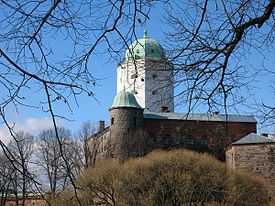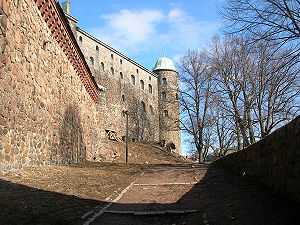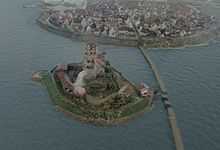Vyborg Castle

Vyborg Castle (Russian: Выборгский замок, Finnish: Viipurin linna, Swedish: Viborgs fästning) is a Swedish built medieval fortress around which the town of Viborg (today in Russia) evolved. Currently it serves as a museum.
General
Viborg Castle was one of the three major castles of Finland. It was built as the easternmost outpost of the medieval Kingdom of Sweden: it is located on the Karelian isthmus, on a little islet in the innermost corner of the Gulf of Finland, in a tight strait which connects Suomenvedenpohja to Bay of Viipuri. It was originally constructed in the 1290s.
The town was originally located inside the outer fortifications of the castle, at the fortress island, but it had to be moved to its present location out of the island because of lack of space.
Medieval history



The construction of the fortress started in 1293 by orders of Torkel Knutsson, the Lord High Constable of Sweden who made in 1290s a so-called crusade to Karelia, the so-called Third Finnish Crusade, actually aimed against Russians, i.e. Novgorod. He chose the location of the new fortress to keep the Bay of Vyborg, which was a trading site used by locals already for a long time. From the bay, a river way goes inland, ultimately connecting the place to several districts, lakes, and indirectly also to rivers going to Ladoga.
The three high-medieval Finnish "castle fiefs" were ruled from the castles of Turku, Hämeenlinna and Viipuri, respectively until the 1360s.
In 1366, Albert III of Mecklenburg was elected king, and according to the German model he began to divide up the castle fiefs, which were immense in Finland, into smaller provinces. In some cases, these new, smaller provinces were given separate bailiffs' residences which have since disappeared; this was the case with the Linnavuori castle mound in Porvoo and the castle of Korsholm in Ostrobothnia, near the today city of Vaasa which was founded later. Only earthworks remain at these sites, but in two places, stone strongholds were built which still exist, although in ruins. One is Raseborg Castle in western Uusimaa (west of Helsinki), the other Kastelholm castle in the Åland (Ahvenanmaa) islands
The castle became the stronghold of the Swedish realm in Karelian regions. Throughout the centuries, it was the first defence of the kingdom against Russians. Its military and strategic status was in the late Middle Ages only second to the fortified capital Stockholm.
The castle and the large surrounding fief became a virtually autonomous principality. Its governors were usually fiefed with the incomes of the county. The fief of Viborg became known as a margraviate. Its governors were generally from the most powerful families of the kingdom. They enjoyed large administrative powers and a good distance from the capital. Those realities made them practically independent rulers. Usually, the castle of Olavinlinna (built in 1470s) was subjugated to Viipuri.
Prominent figures who held Viipuri as their fief, were Bo Jonsson Grip, Christer Nilsson Vasa (1417–42), Karl Knutsson Bonde (1442–48, the future king), Eric Axelsson Tott (1457–81), Knut Posse (1495–97), Sten Sture the Elder (1497–99, between his regencies), Eric Bielke and count John of Hoya. Particularly in 1440s and in late 15th century, the fortresses were further enlarged.
The first mention of firearms in Finland relates to Viborg castle, in 1429. During the Middle Ages the castle was repeatedly besieged by the Russians, most famously in 1495, during the Russo-Swedish War (1495–1497). Governor Knut Posse was in office 1495-1497. The situation of the defenders looked hopeless, but they were saved by the Viborg blast on 30 November 1495, a mysterious explosion which scared off the Russians because they reportedly saw a St. Andrew's cross in the sky.
Modern history


In the 16th century, much was renovated and additions made. In the 17th century, the castle was allowed to decay, as Russian danger was decreased and the border was much more eastwards.
Viipuri was taken by the Russians in 1710, but passed back to Finnish hands in 1812 when all of Old Finland was attached to the autonomous Grand Duchy of Finland. The castle owes its present appearance to extensive restorations undertaken in the 1890s. The military of the Russian Empire used the castle until 1918 for housing administration.
Viipuri belonged to the independent Republic of Finland between 1917–1940 and again 1941-1944. As a result of border changes in World War II it was annexed by The Soviet Union in 1944.
Architecture
The main castle, located in the eastern part of the islet on its highest hill, has an irregular four-cornered layout, with the immense tower of St. Olav (Pyhän Olavin torni in Finnish) as its biggest section. It is 3-4 stories tall, varying in places. Outer defensive works surround the main castle, following the islet's coastlines.
As of January 2013, images of the castle and grounds could be viewed using Google Street View.
References
| Wikimedia Commons has media related to Vyborg Castle. |
- Medieval castles of Finland, by Dr Carl Jacob Gardberg, state archaeologist
External links
| |||||||||||||||||||
| ||||||||||
Coordinates: 60°42′57″N 28°43′45″E / 60.71583°N 28.72917°E
